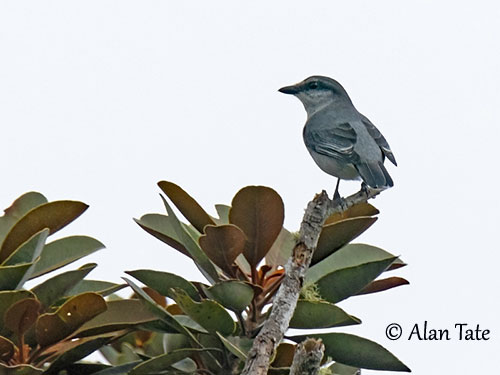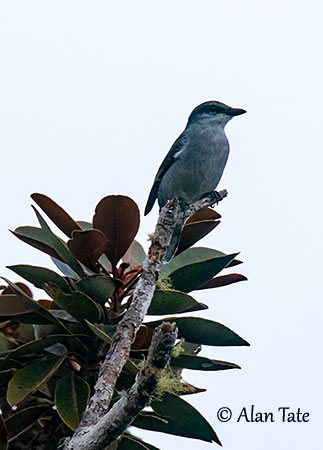
Some displays between adult males, up to 4 birds, are referred as “aerial duels”. The males chase around or over the forest, and then, they return to their own territories.
From some observations by Myles M. Lamont (see the sources at the bottom of the page), several males were calling, and then three of them gathered above the forest canopy. They began to fly in partial unison in a somewhat circular pattern while uttering their harsh “krek” calls. They continued to lightly chase one another, but without dominant or aggressive bird, and no physical contact occurred.
Courtship displays between male and female show the pair on a horizontal branch, about three metres above the ground. The female had a hunched posture and was performing a slow wingbeat every few seconds while uttering a soft call.
The male began to make a lateral display and exposed its upper back to the female, before to jump sideways over her with drooped wings and bobbing tail. It was parallel to the female with extended neck and head pointed towards her. After one minute, the female flew 20 metres to another perch close to the ground, and this behaviour continued for one or two minutes. This behaviour was probably a pre-copulatory situation, but the dense vegetation did not allow to see the birds.
The Mauritius Cuckooshrike is resident on Mauritius. It is agile in flight while foraging, performing hovering and direct flight to catch prey.
REPRODUCTION OF THIS SPECIES:
The breeding season takes place during the rainy season, between September and March.
The Mauritius Cuckooshrike is monogamous and territorial all year round.
Both adults build the nest, a shallow cup, almost a platform. It is made with fine twigs, lichens and spider webs. This structure is attached to a horizontal fork in tree branch.
The female lays 2-3 pale green eggs with brown speckles. Both adults share the incubation during 24-25 days. The chicks are fed by their parents and fledge 22-24 days later. They usually remain in family group during three months. This species produces only one brood per season.
PROTECTION / THREATS / STATUS:
The Mauritius Cuckooshrike is affected by habitat loss and fragmentation caused by intense grazing, agricultural intensification, too frequent or too infrequent burning, and changes in suitable habitat to open-cats coal mines. This species is also vulnerable to Accipiter species coming to the grasslands where they were previously absent, following rapid afforestation and plantation of exotic trees.
The population is roughly estimated to number 607/1,730 individuals, equating to 424/1,210 mature individuals (2018). This population is suspected to be declining.
The Mauritius Cuckooshrike is currently listed as Vulnerable.
Fr: Échenilleur de Maurice
Ang: Mauritius Cuckooshrike
All: Mauritiusraupenfänger
Esp: Oruguero de Mauricio
Ita: Averla cuculo di Mauritius
Nd: Mauritiusrupsvogel
Sd: mauritiusgråfågel
Photographers:
Alan & Ann Tate
AA Bird Photography
Text by Nicole Bouglouan
Sources:
HANDBOOK OF THE BIRDS OF THE WORLD Vol 10 by Josep del Hoyo-Andrew Elliott-David Christie - Lynx Edicions - ISBN: 8487334725
Birds of Madagascar and the Indian Ocean Islands Par Roger Safford, Adrian Skerrett, Frank Hawkins – ISBN: 1472924118, 9781472924117- Editeur: Bloomsbury Publishing, 2015
The Birds of Africa: Volume VIII: The Malagasy Region: Madagascar, Seychelles, Comoros, Mascarenes - Par Roger Safford, Frank Hawkins – ISBN: 1408190494, 9781408190494- Editeur: A&C Black, 2013
Avibase (Denis Lepage)
Birdlife International
Observations on the biology of the Mauritius Cuckoo-shrike Coracina typica
Territorial and courtship displays of Mauritius Cuckooshrike Lalage typica
by Myles M. Lamont
Home page
Page Passeriformes Order
Mauritius Cuckooshrike
Lalage typica ou Coracina typica
Passeriformes Order – Campephagidae Family
INTRODUCTION:
The Mauritius Cuckooshrike is endemic to Mauritius where it is resident. It frequents the native forests of the SW of the island where it is now confined. This species feeds on arboreal arthropods and native geckos, but fruits and eggs of other bird species may be sometimes part of its diet. The Mauritius Cuckooshrike is territorial all year round and monogamous. It nests in a shallow cup built in horizontal fork in native tree in the forest.
This specie is placed in Lalage or Coracina genus depending on the authors. However, DNA analysis suggests that several species formerly classified in the genus Coracina (including the two Mascarene species, Reunion and Mauritius Cuckooshrikes) are part of the larger genus Lalage. But both genera require subdivision, with the Mascarene species remaining in the genus Lalage, whereas the Madagascar Cuckooshrike of genus Coracina could be transferred to a separate genus, including both African and Malagasy Cuckooshrikes.
The Mauritius Cuckooshrike has restricted range and small population. It is threatened by habitat loss and degradation, but also by introduced predators. The species is currently listed as Vulnerable.
DESCRIPTION OF THE BIRD:
Biometrics:
Length: 22 cm
Weight: 43-49 g (the female is slightly larger than the male)
The Mauritius Cuckooshrike adult male has slate grey upperparts, including the lesser upperwing-coverts. Flight-feathers and other wing-coverts are mostly blackish with greyish edges. Primaries and secondaries show white edges and tips. On the uppertail, the rectrices are black with grey edges to central pair, whereas the other tail feathers are tipped white.
On the underparts, chin, throat, undertail-coverts, underwing-coverts and axillaries are white. Rest of underparts is pale grey although breast and flanks are washed grey.
On the head, top and sides are slate grey with whitish upper lores and eye stripe. The ear-coverts are pale grey.
Bill, legs and feet are black. The eyes are brown to hazel.

The female (not displayed) has rufous-brown upperparts, more reddish-brown on rump and uppertail-coverts. The flight-feathers are darker, mostly blackish-brown with reddish-brown edges. The primaries have white tips. On the uppertail, the rectrices are blackish with pale reddish-tips, but the central pair is mostly brown.
The underparts are chestnut, but paler on the underwing-coverts.
The juvenile has brown upperparts with buff and blackish crescent-like markings. The underparts are pinkish-white with dark streaks. The immature is similar to female. The young male shows mixed white and chestnut on the underparts.
RANGE:
The Mauritius Cuckooshrike is found in SW Mauritius Island.
HABITAT:
The Mauritius Cuckooshrike frequents forests with native trees, even where the canopy is broken. It can be seen in adjacent heavily invaded forest by exotic plant species. It is visible between 200 and 800 metres of elevation, but usually mainly above 460 metres.
CALLS AND SONGS: SOUNDS BY XENO-CANTO
Both male and female give a variable “buzz kek” as contact call. It may be repeated and is often followed by a hard “tschrek”. We can also hear a scolding “kek” and an aggressive squeak.
The Mauritius Cuckooshrike male gives a territorial song from perch, a series of short whistles following some faster introductory notes.
BEHAVIOUR IN THE WILD:
The Mauritius Cuckooshrike feeds on arboreal arthropods and native geckos. The diet includes mainly native geckos, green bush crickets (Tettigoniidae), stick insects (Phasmatodea) and mantises, and less often caterpillars, adult Lepidopterans, cicadas, dragonflies and spiders.
It hunts by jumping or flying between branches, searching for prey on trunks, branches, leaves and twigs. It usually gleans the prey or catches them in the air by hovering or flying. The larger food items are usually beaten against a branch before to be swallowed.
The Mauritius Cuckooshrike is usually found alone, in pairs or in family groups. It is sedentary and resident, and defends a territory all year round by singing, but also by aerial displays of fights against intruders. This species is monogamous.
